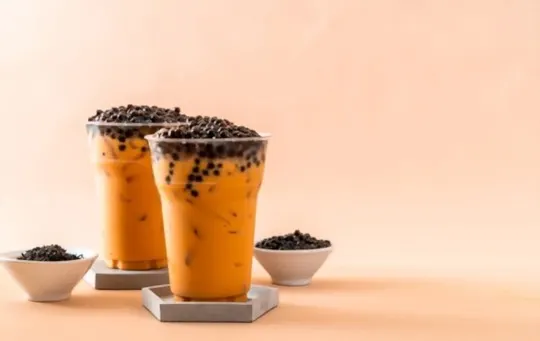Craving a delicious, creamy cup of Thai milk tea? You’re in luck.
Discover the creamy, smooth flavors of this iconic drink and how to make it at home.
With a unique blend of sweetness and aromatic spices, you’ll be amazed at how divine this unique flavor tastes.
Let’s get sipping.
What is Thai Milk Tea?

Thai milk tea, otherwise known as cha yen or cha nom sot, is a beverage popular all over Thailand.
It’s an aromatic, creamy concoction made with strong black tea, evaporated milk, and a variety of sweetener options.
This delicious combination creates a powerful flavor that’s savory but also sweet in an interesting way.
It has hints of vanilla and cinnamon; some variations also have other spices added for complexity.
Though not as widely known here in the U.
S.
, Thai milk tea is typically served hot and usually at cafes, restaurants, or street food vendors throughout Thailand.
As its name suggests, it is made using both evaporated and condensed milk to add the creamy texture associated with it — although other types of milk can be swapped in instead for a lighter version if desired.
Other frequently used ingredients include sugar (or sugar alternative), pandan flavor extract for subtle sweetness and notes of vanilla, ginger root for added spice, star anise for spice complexity, cardamom powder or espresso powder (depending on preference).
What Does Thai Milk Tea Taste Like?

Thai milk tea is a popular beverage enjoyed in many parts of Southeast Asia.
It has a distinct taste that is often savored by both local and international customers alike.
The unique flavor is created by combining tea leaves, spices, and dairy or other types of milks like coconut or almond.
The sweetness of Thai milk tea depends on one’s preference, as there are many different variations.
Most commonly it is made with a blend of condensed and evaporated milks for a creamy, smooth flavor that includes notes of sweetness from the additives like sugar or honey.
Additionally, spices like cardamom and star anise are mixed in to provide an exotic flavor profile with warmth and depth.
For those who may not be used to these flavors yet, Thai break tea can be an acquired taste.
After drinking it for the first time you may notice notes of chickory with a slightly earthy aftertaste that lingers due to the use of black Assam tea leaves that are brewed with pre-boiled water to achieve a full-bodied drink overflowing with intense flavors that linger in your mouth long after each sip.
To accommodate different tastes in Thailand some establishments offer more customized versions such as adding strawberry syrup or grass jelly – the latter being the more traditional option – but its main flavors rely on this perfect mix of tealeaves, spices and milky sweetness to create its notorious fame among locals and travelers alike.
Ingredients that Affect the Taste of Thai Milk Tea

The vivid flavor of Thai Milk Tea owes its deliciousness to the combination of ingredients within each recipe.
The three key elements that shape the taste of your favorite beverage include tea leaves, sugar, and either cow or coconut milk.
Tea leaves are often a blend of Assam black tea and Ceylon black tea, both grown in India or Sri Lanka.
Assam tea is richly flavorful and mellow, with strong chocolate overtones; it gives Thai Milk Tea its signature earthy taste.
Ceylon tea is sweet and citrusy, imparting subtle floral notes to the brew.
Because the flavor of Thai Milk Tea depends largely on a balanced ratio betweenAssam and Ceylon tea leaves, the quantity and variety of each type can vary significantly depending on who’s brewing it—making every cold glass unique.
We recommend experimenting with different blends until you find one that matches your personal preference best.
The amount of sugar added to the drink is also an important factor in determining the flavor profile: Too much will result in a syrupy disproportion between sweet flavors; too little may make the drink seem dull compared to its full-bodied character when prepared correctly.
Keep in mind that different brands typically use either white granulated sugar or brown rock sugar, which also has an effect on sweetness levels as well as overall texture.
Finally, Thai Milk Tea recipes usually incorporate either cow’s milk or coconut milk for creaminess — some versions incorporate both.
Cow’s milk works better for those who want a less intense flavor profile for their brew (and hanker after something more reminiscent of traditional British tea with condensed milk).
Coconut milk has grown popular over time due its plant-based properties; molecular studies confirm that this dairy-free option actually awakens more aroma receptors than cow’s milk because its lactose content enhances aromas released by warming lactic acid molecules while heating up but not boiling into bubbling liquid.
This means that if you’re aiming for maximum punchiness with each sip, coconut milk should be at top of your list when it comes to choosing a dairy input.
1 – Black Tea Leaves
Thai milk tea, also known as cha yen in Thai, is traditionally made by boiling strongly brewed black tea with condensed milk or evaporated milk along with sugar and sometimes salt.
This combination of tea and sweetened dairy creates a creamy orange-brown beverage with a flavor that’s distinctively rich, sweet and milky.
Black tea leaves are essential for producing Thai milk tea due to their smooth full-bodied flavor.
They are steeped at a high temperature for several minutes until the desired strength is reached.
A variety of black teas can be used for this traditional beverage including Assam, Darjeeling and Ceylon – each offering its own unique aromatic notes from dried fruit flavors to malty notes or even hints of smoke.
Different regions in Thailand may also use other types of herbal teas such as pandan leaves, ginger root and/or lemongrass for additional aromatics.
2 – Condensed Milk
Thai milk tea is made of steeped Ceylon black tea, sugar, and sweetened condensed milk.
The condensed milk is what gives it the decadent, perfectly balanced sweetness.
The use of condensed milk in many Thai-inspired beverages has a special significance in Thai culture.
In fact, in the south of Thailand, people traditionally celebrate special occasions like weddings or birthdays by offering a fresh coconut or bowl of sweetened condensed milk.
The flavor of condensed milk is a balance between sweetness and creaminess.
It has a much sweeter taste than cream and because it’s already been cooked and reduced down to 1/3 its original volume, it’s much more concentrated than either standard whole or skimmed dairy milks.
The addition of thick condensed milk to Thai Milk Tea balances the embittered notes from the steeped tea leaves with its mellow sweetness — making for an enjoyable drink.
3 – Spices and Flavorings
Thai milk tea is made from a combination of spices — some of which are quite pungent — to achieve its signature flavor.
Common ingredients include star anise, tamarind, cardamom, and sometimes cinnamon.
These are combined with other flavors that are unique to Thai milk tea, including salt and sugar.
The amount of each spice used is carefully balanced by the barista to create a unique and unique flavor profile for each cup.
The sweetness relies heavily on both the addition of sugar and the creaminess of evaporated milk.
Being dairy-free, some establishments use alternatives such as condensed milk or coconut cream along with their own recipes.
By manipulating different flavors within Thai milk tea, customers can expect subtle yet distinguishable variations in taste from one venue to the next.
How to Make Thai Milk Tea at Home?

Thai Milk Tea is a delicious and popular beverage that’s well-loved in Southeast Asia.
With its sweet and creamy flavor, it’s perfect for the hot summer days and great for sharing with friends.
While it’s traditionally made with black tea, condensed milk, and sugar, you can also customize it to satisfy your taste buds.
If you’re interested in making Thai Milk Tea at home, here are the steps to follow:
- Make the black/Thai tea: Boil one cup of water. Turn off the heat and add one teaspoon of loose leaf or tea bag of black/Thai tea to the pot. Let it steep for 5 minutes until the leaves have fully opened up. Strain out all the leaves and remove from heat.
- Prepare your glasses: Put two tablespoons of condensed milk into each glass – use more or less according to your preference level of sweetness. Swirl around gently to combine before adding ice cubes if desired.
- Add tea: Distribute equal portions of the brewed tea between each glass using a spoon or measuring cup. Gently stir each glass after pouring in a few drops of food colouring if desired.
- Put on finishing touches: Lastly, add drops of rose syrup or other flavouring-of-choice into each glass (optional), then top off with more ice cubes before serving. Enjoy chilled.
Nutritional Value of Thai Milk Tea
Thai milk tea is a sweet and creamy beverage that has become a popular drink in many countries around the world.
This traditional Thai drink is made with black tea, evaporated or condensed milk, and other spices.
While it’s not as popular as coffee, Thai milk tea provides some key benefits that can help to promote overall health.
The nutritional value of Thai milk tea depends largely on the ingredients used in making the drink.
Generally speaking, Thai milk tea contains about 180 calories per 8-ounce cup, with 12g of fat, 16g of carbohydrate, and 4g of protein.
Additionally, this beloved drink contains notable amounts of calcium – which helps maintain healthy bones – and potassium – which plays an important role in regulating heart rate and blood pressure.
Additionally, trace amounts of other essential vitamins and minerals can be found in Thai milk tea such as: magnesium-which helps regulate nerve impulses; zinc-which helps support healthy skin; folate-which helps make new cells; vitamin B6-which helps break down proteins; and manganese-which helps support bone development.
While it’s sometimes maligned for its high fructose corn syrup content – many commercial brands contain this ingredient in place of sugar – those choosing to consume this beverage should be aware that even if sugar isn’t added to the cup it still contains calories from fat or carbohydrates present in the evaporated or condensed milk used to make the drink.
That said, when consumed responsibly by moderation – no more than one dish per day – Thai Milk Tea can be enjoyed without feeling guilty about its contents.
History and Popularity of Thai Milk Tea

Popular throughout Southeast Asia, Thailand included, Thai Milk Tea has been around for centuries.
This creamy, sweet and spiced tea draws its unique flavor from a variety of ingredients.
It is made with condensed milk or coconut milk and a combination of tea leaves, star anise and other spices like cardamom or pandan extract.
Originally known as “cha-yen” in Thai, this beverage was first consumed by the royal families in Thailand during the 1600s.
Today it has become a staple part of Thai culture and it is enjoyed by people of all ages in cafes (known as Cha-dom) around the country.
Thai Milk Tea is so immensely popular that there are numerous variations to the recipe; some versions may include egg yolks for an extra layer of richness, while others may add spices such as nutmeg or cinnamon to enhance its flavor profile.
Additionally, this drink has been adapted to western culture and is becoming increasingly more popular in western countries due to its unique taste and cultural value.
Where to Buy Thai Milk Tea and When it’s Available
Thai milk tea can be found in the US at many Asian grocery stores, cafes and restaurants.
It is also available online through websites such as Amazon and Tea Forte.
Additionally, there are many producers that specialize in Thai milk tea varieties and offer their products in supermarkets and online.
The availability of this particular beverage tends to vary depending on the season, with winter being the most popular time due to its heavier taste and warmth when served hot.
However, it can also be found all year round as production increases during summer months for its refreshing coolness when served cold.
Conclusion
Thai milk tea is a flavorful, creamy, and refreshing beverage.
It owes its signature flavor to a blend of sweetened black tea and spices like cardamom.
Unlike milk teas from Japan or Taiwan, it is usually served with a heavy dose of sugar and condensed milk, giving it a rich and sweet taste.
It has become popular around the world due to its balance between lightness from the tea, creaminess from the milk, sweetness from the sugar, and spiciness from added ingredients like star anise.
If you are looking for something to have on a hot day or just as a refreshing treat after dinner, Thai milk tea could be for you.
Whatever your preference in flavor or amount of sweetness and spice you prefer, there is sure to be one that suits your needs.

What Does Thai Milk Tea Taste Like? A Comprehensive Guide
Ingredients
- Thai Milk tea
- Ingredients from your selected recipes
Instructions
- Select your favorite ingredient from the range available in this article.
- Collect all the necessary items to make the recipe.
- Use the instructions provided to prepare a delicious dish in 30 minutes or less.

Carrie is a food writer and editor with more than 15 years of experience. She has worked for some of the biggest names in the food industry, including Bon Appétit, Food & Wine, and Martha Stewart Living.
As the Editor in Chief of IntroChicago.com, Carrie oversees all of the content on the site. She also manages the team of contributing writers and editors, who help to create delicious recipes, helpful tips, and informative articles that you’ll find on the site.
A native of the Chicago area, Carrie is passionate about all things food. She loves trying new restaurants and experimenting with new recipes in her kitchen. She’s also a graduate of the Culinary Institute of America, so she knows a thing or two about food!
